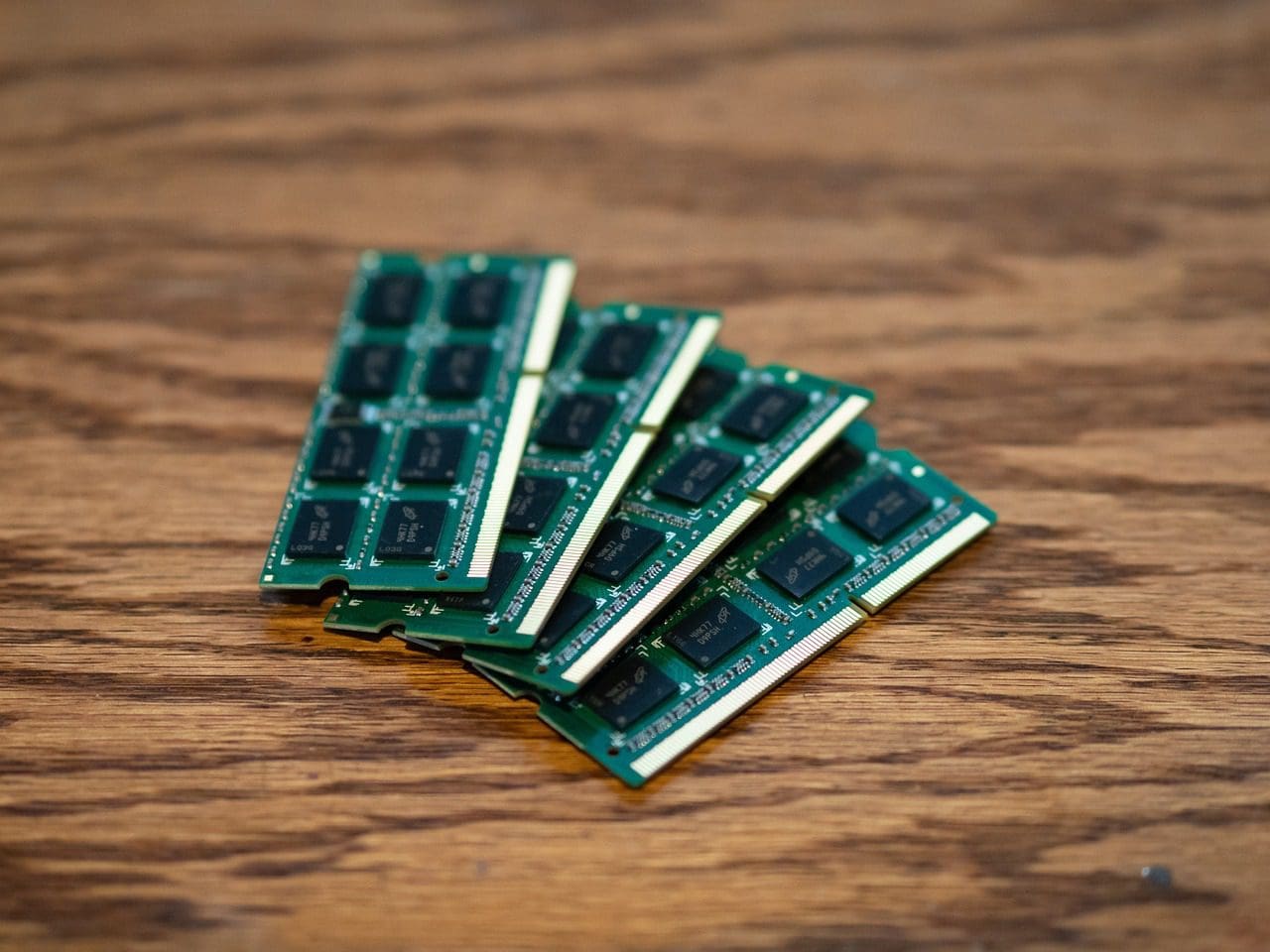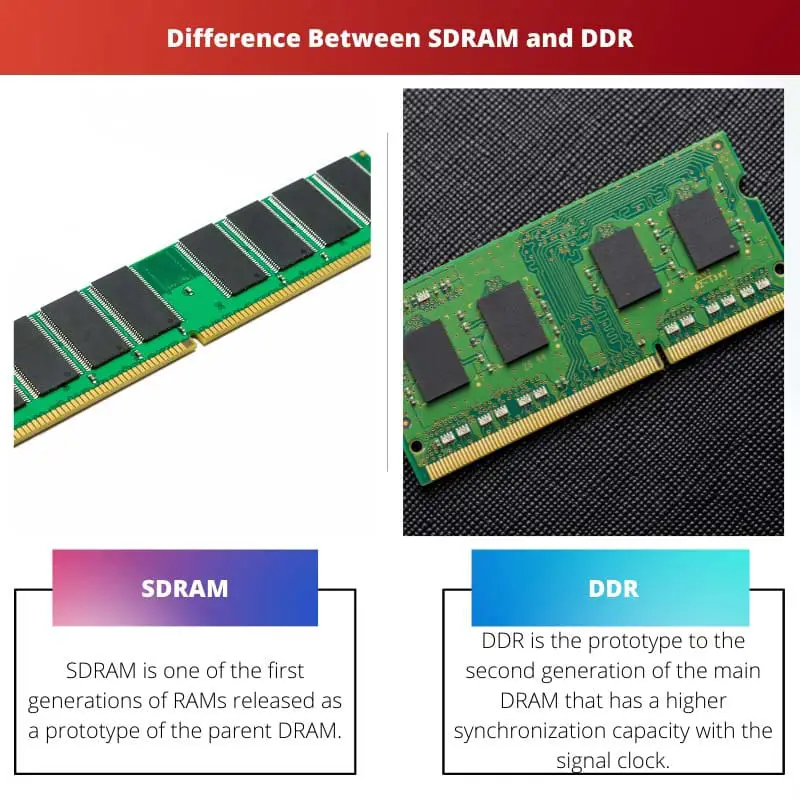SDRAM and DDR are both two subtypes of Random Access Memory that have fallen into different categories and generations of the main type of RAM called DRAM.
They have inbuilt memory ICs (Integrated Circuits) that assist them in the smooth running and functioning of RAM for the hardware device that it is connected to.
Key Takeaways
- SDRAM is a single data rate memory, while DDR is a double memory.
- DDR offers twice the data transfer rate of SDRAM, resulting in better performance.
- DDR consumes less power than SDRAM, making it more energy-efficient.
SDRAM vs DDR
SDRAM stands for Synchronous Dynamic Random Access Memory. It is an older memory technology commonly used in computers in the 1990s and early 2000s. DDR stands for Double Data Rate. It is a newer type of memory technology that was introduced in the early 2000s and is still used in modern computers.

SDRAM is one of the first generations of RAMs released as a prototype of the parent DRAM. Its synchronization with the clock signal is the main determining factor when users need RAM.
It was in demand for the longest period until a new generation of RAMs was unfolded and the drop in the market for SDRAM users ultimately almost nullified its production.
DDR is the prototype of the second generation of the main DRAM that has a higher synchronization capacity with the signal clock that helps in the data transfer or completion of a specific operation assigned to the DDR.
Owing to its structural difference from the other generation of RAMs, it has had a lower market value.
Comparison Table
| Parameters of Comparison | SDRAM | DDR |
|---|---|---|
| Year of Release | 1997 | 2000 |
| Speed | Slower in comparison | Almost twice as fast as SDRAM |
| Voltage at Which it Works | 3.3 volts | 2.5 volts (standard DDR) and 1.8 volts (DDR with low voltage) |
| Data Rate | 0.8-1.3 Gigabytes per second | 2.1-3.2 Gigabytes per second |
| Data Transfer Time Between Every Cycle | 1 Nanosecond | 2 Nanosecond |
What is SDRAM?
SDRAM stands for Synchronous Dynamic Random Access Memory and was released in the year 1997.
It has been manufactured with many features taken off the DRAM memory supplement in a way, making it the first in line among many generations of DRAM to come.
SDRAM is commonly categorized as the first generation of the parental type DRAM, giving it credibility in the market as purchasers keep many newly launched products off-limits.
It has an interface that helps in the synchronizing process. This shows that SDRAM can wait for clock signals to be given to it before each operation is completed.
Its physical structure comes with two notches that are to act as the point of connection with about 168 pins to help in the data transfer and storage.
As it is RAM, it functions as long as the connected main device or system remains active or logged in by the user.
Therefore, erasing all of its activity and temporarily storing data as soon as the device is shut down or logged out.
It has a comparatively less speed when seen together with the later generations of the parental DRAM.
With speeds ranging between 66MHz, 100MHz, and 133MHz, it could be called one of the slowest available RAM.
This lack of speed is because a single word is transmitted between synchronized operations per clock cycle.
This happens as SDRAM makes use of just the rising edge of the synchronized signal for transferring the data.
This means that SDRAM can’t overlap operations.

What is DDR?
DDR stands for Double Data Rate RAM, which was released in 2000.
Due to its product type and eventual complete look, it has been called a second generation of the DRAM and a sister prototype of the SDRAM.
It holds multiple features of the basic SDRAM giving it a place in the synchronous dynamic RAM family.
It is also called DDR1, though this name was later given to other newly constructed RAMs in the same generation.
Its structural construction includes a single notch point to which external device connections are made, and it gives the DDR the connection capability.
To assist the data transfer and storage functions of the DDR, it has got around 184 pins.
Its data transfer capacity is almost twice that of the previous generations’ RAMs and compared to the parent DRAM.
With transfer speeds ranging from 200 MHz to 400 MHz with minor values in between, such as 266 MHz and 333MHz.
This speed difference is catered to with the help of the fact that DDR doesn’t have to wait for the completion of each operation or data transfer to move on to the next.
This means that DDR can easily overlap its operations and data transfer, doubling up the speed, and can read two values per cycle.
The reading of the assigned clock signal’s rising edge and falling edge achieves the reading of 2 values.

Main Differences Between SDRAM and DDR
- While SDRAM has a structural makeup of two connection notches that assist in hardware connection and about 168 external pins for data transfer and operations, DDR has a single notch at the connector and a greater number of the pin that is 184.
- DDR has a speed category ranging from 200 MHz, 266MHz, 333MHz, and 400MHz, almost double the speed range given to SDRAM of 66MHz, 100MHz, and 133MHz.
- SDRAM is called the first generation of parental DRAM, whereas DDR is called the second generation of the prototype, both of which have their new variations combined with the features of the prototype.
- In the case of DDR, the microprocessor chip reads both the rising edge as well as the falling edge of the clock signal, but for SDRAM, only the rising edge is taken into consideration and thereby reducing the values read per cycle.
- The working voltage of SDRAM is 3.3 volts, whereas in the case of DDR, the voltage value is different depending on the type of RAM. It ranges from 2.5 volts for the standard type and about 1.8 volts for the lower category depending on the purchaser’s needs.


The comparison table was enlightening, now I know exactly which one to choose for my computer.
The writing was clear but the content is outdated. Aren’t there newer technologies worth discussing?
Yes, I agree. The article could benefit from more up-to-date information.
I thought the tone of the article was straightforward and easy to understand. It’s ideal for someone like me with a basic knowledge of computers.
I found the article to be quite educational and informative, great job!
Completely agree! I learned a lot about RAM from this article.
The technical comparison in this article is very useful for anyone looking to understand the differences between SDRAM and DDR.
The article describes the inner workings of RAM very precisely, good read!